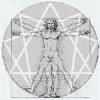Somewhere about this time I was very much struck by a talk about the sun, the planets, and the moon. I do not remember how this talk began. But I remember that G. drew a small diagram and tried to explain what he called the “correlation of forces in different worlds.” This was in connection with the previous talk, that is, in connection with the influences acting on humanity. The idea was roughly this: humanity, or more correctly, organic life on earth, is acted upon simultaneously by influences proceeding from various sources and different worlds: influences from the planets, influences from the moon, influences from the sun, influences from the STARS. All these influences act simultaneously; one influence predominates at one moment and another influence at another moment. And for man there is a certain possibility of making a choice of influences; in other words, of passing from one influence to another. Fragments: One
“For the astronomer the world will be a world of STARS and nebulae. Fragments: Four
“For the sun, in its turn, ‘world’ is our world of STARS, or the Milky Way, an accumulation of a vast number of solar systems. Fragments: Four
“If we take one of the many worlds created in the Absolute, that is, world 3, it will be the world representing the total number of starry worlds similar to our Milky Way. If we take world 6, it will be one of the worlds created within this world, namely the accumulation of STARS which we call the Milky Way. World 12 will be one of the suns that compose the Milky Way, our sun. World 24 will be the planetary world, that is to say, all the planets of the solar system. World 48 will be the earth. World 96 will be the moon. If the moon had a satellite it would be world 192, and so on. Fragments: Four
“Of course there are very many people who consider that the life of humanity is not proceeding in the way in which according to their views it ought to go. And they invent various theories which in their opinion ought to change the whole life of humanity. One invents one theory. Another immediately invents a contradictory theory. And both expect everyone to believe them. And many people indeed do believe either one or the other. Life naturally takes its own course but people do not stop believing in their own or other people’s theories and they believe that it is possible to do something. All these theories are certainly quite fantastic, chiefly because they do not take into account the most important thing, namely, the subordinate part which humanity and organic life play in the world process. Intellectual theories put man in the center of everything; everything exists for him, the sun, the STARS, the moon, the earth. They even forget man’s relative size, his nothingness, his transient existence, and other tilings. They assert that a man if he wishes is able to change his whole life, that is, to organize his life on rational principles. And all the time new theories appear evoking in their turn opposing theories; and all these theories and the struggle between them undoubtedly constitute one of the forces which keep humanity in the state in which it is at present. Besides, all these theories for general welfare and general equality are not only unrealizable, but they would be fatal if they were realized. Everything in nature has its aim and its purpose, both the inequality of man and his suffering. To destroy inequality would mean destroying the possibility of evolution. To destroy suffering would mean, first, destroying a whole series of perceptions for which man exists, and second, the destruction of the ‘shock,’ that is to say, the force which alone can change the situation. And thus it is with all intellectual theories. Fragments: Fifteen

